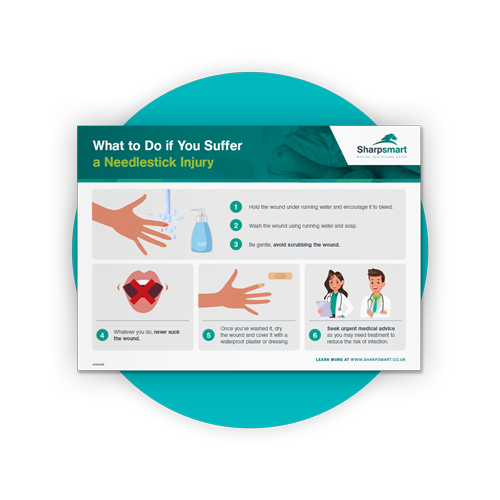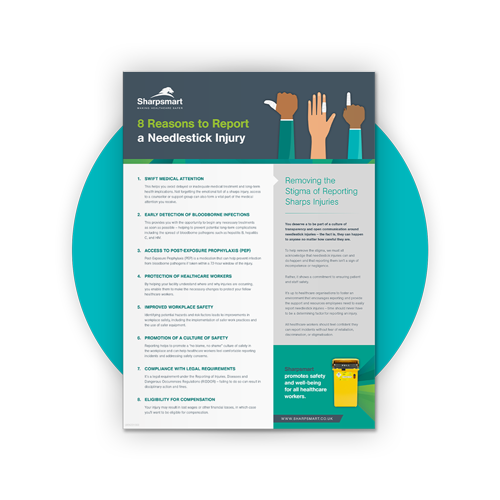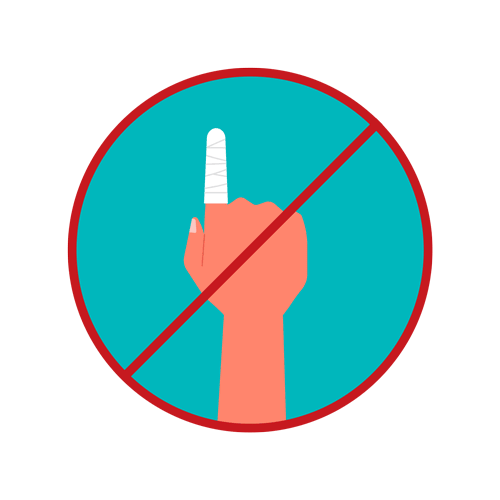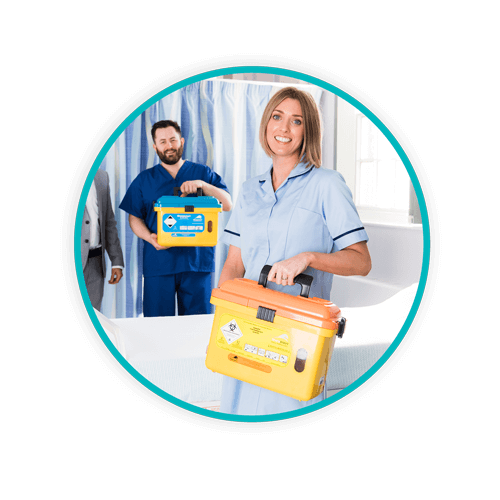Why Should You Report A Needlestick Injury?

Have you ever suffered a sharps injury in silence? Needlestick injuries are one of the biggest occupational hazards within the healthcare environment, having the potential to put your health and job at risk – not to mention the resulting stress and trauma. Despite that fact, they go vastly unreported. 17% of the 7,571 members of the Royal College of Nursing surveyed in 2020 said they’d suffered a sharps injury without reporting it. The time following a sharps injury can be distressing, uncertain, and emotionally draining – often the last thing on your mind will be reporting it, but doing so can help protect healthcare workers and create a safer environment for all. We’ve put together a shortlist of reasons you should report a sharps injury, but first, let’s have a quick refresher on what to do if you get stuck.
TOPICS WE WILL COVER:
1 / What to do if you suffer a needlestick injury
2 / 8 Reasons to report a needlestick injury
3 / Removing the stigma of reporting sharps injuries
4 / Reporting a needlestick injury
5 / Creating a safer healthcare environment
What to Do if You Suffer a Needlestick Injury
We know you put your all into caring for your patients, but accidents happen. If you ever suffer a sharps-related injury, it’s essential to know what to do in the immediate aftermath. If you pierce or puncture your skin with a used needle or sharp, here’s what you need to do:
1. Hold the wound under running water and encourage it to bleed.
2. Wash the wound using running water and soap.
3. Be gentle, avoid scrubbing the wound.
4. Whatever you do, never suck the wound.
5. Once you’ve washed it, dry the wound and cover it with a waterproof plaster or dressing.
6. Seek urgent medical advice as you may need treatment to reduce the risk of infection.
Once you’ve taken the first steps towards recovery, it’s time to report your injury following local reporting procedures and make sure your local RCN safety representative is aware. It’s important to report ALL sharps injuries and not only those that result from a used needle or sharp.
Remember, your health is important too!
In case you do struggle to remember what to do, you can download this “What to Do If You Suffer a Needlestick Injury” poster for free.
A Note on Needlestick Injuries
These types of injuries occur when healthcare workers accidentally get pricked or cut by needles or other sharp objects during medical procedures. But don’t be fooled by the name – it’s not only needles that can cause these injuries. Sharps can include a whole range of medical equipment like syringes, scalpels, lancets, and even broken glass from equipment. We recently partnered with the Royal College of Nursing to discuss needlestick injuries and their recently published sharps safety guidance in a webinar which is now available on demand:
Sharps Safety – Guidance on the Prevention and Management of Sharps Injuries
Finding the Time to Report a Sharps Injury
One of the biggest obstacles to reporting a sharps injury is time, or more accurately, a lack of it. Time is a valuable resource and this seems more true in the healthcare environment than in most other settings – how many shifts have you finished wondering where the time went? Despite this, finding the time to report any sharps injury you sustain is important for your health, and you deserve access to the help you may need as soon as possible.
8 Reasons to Report a Needlestick Injury
We were never going to settle on one good reason to report a sharps-related injury, we decided instead to compile a list of 8 reasons:
Swift Medical Attention
This helps you avoid delayed or inadequate medical treatment and long-term health implications. Not forgetting the emotional toll of a sharps injury, access to a counsellor or support group can also form a vital part of the medical attention you receive.
Early Detection of Bloodborne Infections
This provides you with the opportunity to begin any necessary treatments as soon as possible – helping to prevent potential long-term complications including the spread of bloodborne pathogens such as hepatitis B, hepatitis C, and HIV.
Access to Post-Exposure Prophylaxis (PEP)
Post-Exposure Prophylaxis (PEP) is a medication that can help prevent infection from bloodborne pathogens if taken within a 72-hour window of the injury.
Protection of Healthcare Workers
By helping your facility understand where and why injuries are occurring, you enable them to make the necessary changes to protect your fellow healthcare workers.
Improved Workplace Safety
Identifying potential hazards and risk factors leads to improvements in workplace safety, including the implementation of safer work practices and the use of safer equipment.
Promotion of a Culture of Safety
Reporting helps to promote a “no blame, no shame” culture of safety in the workplace and can help healthcare workers feel comfortable reporting incidents and addressing safety concerns.
Compliance with Legal Requirements
It’s a legal requirement under the Reporting of Injuries, Diseases and Dangerous Occurrences Regulations (RIDDOR) – failing to do so can result in disciplinary action and fines.
Eligibility for Compensation
Your injury may result in lost wages or other financial losses, in which case you’ll want to be eligible for compensation.
Help your staff and fellow healthcare workers stay mindful of the importance of these reasons by downloading our “8 Reasons to Report a Needlestick Injury” poster.
Removing the Stigma of Reporting Sharps Injuries
You deserve a to be part of a culture of transparency and open communication around needlestick injuries – the fact is, they can happen to anyone no matter how careful they are. To help remove the stigma, we must all acknowledge that needlestick injuries can and do happen and that reporting them isn’t a sign of incompetence or negligence.
Rather, it shows a commitment to ensuring patient and staff safety. It’s up to healthcare organisations to foster an environment that encourages reporting and provide the support and resources employees need to easily report needlestick injuries – time should never have to be a determining factor for reporting an injury. All healthcare workers should feel confident they can report incidents without fear of retaliation, discrimination, or stigmatisation.
Reporting a Needlestick Injury
The Health and Safety (Sharp Instruments in Healthcare) Regulations 2013 highlight a duty for both employers and employees when it comes to reporting a needlestick injury:
Employers
The safety of your staff is a top priority, so it’s crucial to take immediate action when any sharps-related incident occurs in which an employee may have been exposed to a blood-borne virus. You must make a record of the incident when you’re notified of it, investigate the circumstances and causes of it, and take any action required.
Here’s how you can support your employee:
1. Ensure they have immediate access to medical advice.
2. Offer them the medical treatment recommended by their doctor – early intervention is key to preventing the transmission of serious illnesses like HIV and hepatitis.
3. Needlestick injuries can be traumatic and take an emotional toll – offer your employees counselling if needed to help them cope and move forward.
By taking these steps, you’ll be fulfilling your duty of care as an employer and demonstrating that you value the health and well-being of your employees.
Employees
Needlestick injuries are often a stressful and scary experience, but reporting an incident in as much detail and as soon as possible helps your employer investigate it effectively.
Here are some key questions to try to answer in your report:
- Who was injured?
- When and where did the incident occur?
- What type of sharp was involved?
- At what stage of a procedure or disposal did the injury occur?
- How severe was the injury?
The more details you’re able to provide, the better equipped your employer will be to conduct a thorough investigation, take appropriate action, and get you the help you’re entitled to.
A Note on Needlestick Injury Investigations
The extent of an investigation will vary depending on the severity of the incident. For example, if you injure yourself with a clean needle your employer may only need to record the details and provide any necessary first aid. However, an injury involving a used needle will require a more in-depth investigation that keeps an appropriate record of the findings. Investigating a sharps injury is about more than identifying what went wrong, it’s also about ensuring it doesn’t happen again. The overarching purpose for conducting such investigations is accident prevention, not pointing fingers and placing blame – always remember, you’re not in the wrong.
You Deserve a Safer Healthcare Environment
It’s your right as a healthcare worker to feel like you can report a needlestick injury without any blame or shame and without time being an obstacle that prevents you. So, let’s work together to make healthcare safer and create a no blame, no shame culture that promotes safety and well-being for all healthcare workers. If you’d like more information on sharps safety or are looking for safer solutions for sharps management and disposal, don’t hesitate to get in touch with one of our experts.
Let's Talk!
Your time is valuable, and we don’t want to play hard to get. You can either phone us directly on the details listed on our contact page, or feel free to fill out this short form and one of our team members will get back to you as quickly as possible.
